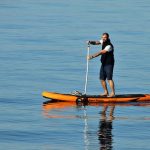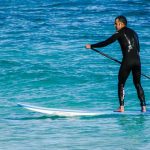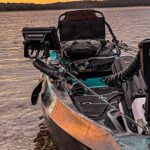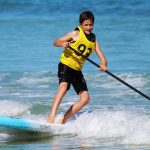The SUP world has been inundated by inflatable stand up paddle boards during the last five years.
Most SUP establishments ran out of their stock during the first 12 months of the pandemic, as the activity of paddling provided an excellent method for getting outdoors while still observing social distancing protocols.
Paddle boarding provided an ideal situation during the pandemic, since it allowed people to get outdoors to get natural vitamin D and exercise their bodies concurrently.
Inflatable SUP boards made the activity available to people who may not have otherwise done it; part of the reason being their affordability, but mostly because they can be transported and stored with very little difficulty. Inflatables are ideal for beginners because they are gentler on the body in the event of a fall compared to rigid boards.
The paddle board can be traced back many millenia. The beach boys of Waikiki are typically credited with developing modern SUP. The sport of big wave surfing achieved worldwide recognition when Laird Hamilton and Dave Kalama breathe new life into it in 1995 at Hawaii.
The main downside to hard paddleboards was that they were hard to transport, which meant they weren’t a viable option for people who lived in apartments in big cities.
INFLATABLE PADDLE BOARD CONSTRUCTION
It’s been some time since inflatable kayaks were introduced to the kayaking world, so the emergence of inflatable standup paddle boards as an option was inevitable. Over time, various companies that exclusively sold inflatable stand up paddle boards appeared in the market.
Brands such as Thurso Surf, Sea Eagle, and Red Paddle (yes, even a red paddle is available) have become available.
The original blow-up SUPs weren’t exactly strong, so the best brands made alterations to their design. The many sheets of tough military vinyl were joined together to enfold a mass of thousands of fibres that were held in place at the top and bottom layers using knit drop stitch.
Brands of paddle boards like Glide SUP and Red Paddle utilize a woven dropstitch building style, which generates a significantly firmer board. The tough, military-grade PVC greatly reduces the chances of a puncture. No one wants to be on a decreasingly buoyant board.
Cheaper boards still tend to use single layer PVC. They are more similar to pool toys rather than serious recreational gear.
TOP PADDLE BOARD BRANDS ADVANTAGES
Enthusiasts of stand up paddle boarding favor top brands over budget models because they provide a more satisfying paddling experience. The intertwining drop stitch construction along with several layers of military-grade PVC permits some of these inflatable paddle boards to be fully pressurized to 25 PSI when utilizing a pump. PSI stands for “pounds per square inch”.
To have the same velocity as a solid stand up paddle board, you must obtain an inflatable board that can be pumped up to a pressure of 20 pounds per square inch or higher.
Paddlers who are attempting to get a bargain finish up with a board that bends in the middle when pressure is applied.
This means that when you are at the center of the board in the water, the front and back will come out of the water, making it difficult to paddle these types of stand up paddle boards.
INFLATABLE PADDLE BOARDS SHOULD BE RIGID
If you want to purchase an inflatable SUP to go on tours or just to practice surfing, you will want to make sure it is as firm as possible. That is why you need to carefully look into the brand you decide on. Don’t simply choose the previous year’s design because it is discounted.
Inflatable SUPs have become almost as stiff as boards that are not inflated.
Be certain to obtain a variation of the model that meets your canoeing demands. A sturdier board will assist you in braving choppier seas since you will rarely encounter completely placid water.
One thing to take into account when scouting for inflatable paddle boards is their weight limit, particularly if you plan on having a few people on the board. Taking pleasure in the pastime of riding a paddleboard brings the possibility of having your children, or even your pet, along as you go.
Fortunately, the weight limit of inflatable stand up paddle boards (SUPs) is not a major issue since they are thicker than regular boards; therefore, multiple people can be on the boards without a problem.
INFLATABLE PADDLE BOARD ACCESSORIES
Brands that are more highly regarded generally pack a lot of SUP accessories with their boards, while inferior brands require customers to buy them as separate items. It is common for inexperienced visitors of an inflatable paddle board site to neglect taking into consideration a few essential details.
You should not be charged extra for items like a backpack with wheels, a paddle, double chambered hand pump, kayak chairs, center fin (depending on the design of the SUP), and a fix set. The kayak seat comes in handy for most beginners.
The backpack allows for a simple way to keep your SUP organized.
Choosing the Inflatable SUP for you
What number of attachment points does the inflatable paddle board have? Are there fastenings such as bungee cords available to secure your items in watertight sacks? What kind of difficulty would be involved in transporting the board with a vehicle and then bringing it to the water?
One more factor to examine when analyzing the different SUP companies is: how many years have they been manufacturing boards? Do they back up their paddle boards or simply concentrate on furnishing an increasing number of deals?
It is possible to find many designs of inflatable SUPs. When you purchase an inflexible paddle board, it is important to decide what purpose it is intended to serve.
It can be overwhelming to decide from among the numerous SUP activities which one to engage in.
When buying your first inflatable board, there are a few factors to consider: width, weight limit, tie-down points, relatively calm or turbulent waters, pointed or more rounded noses, and desired fin design.
Board Categories
If you’re new to stand up paddleboarding, you should probably invest in an inflatable all-around SUP (stand up paddleboard) so that you can explore many different areas and paddle in a variety of ways.
If you have prior knowledge in Stand Up Paddleboarding or other board sports, and you’re seeking for speed, you should explore boards in the sport/performance category.
If you are trying to minimize the chance of you slipping over and to help build your trust in your knowledge, you should look for an especially stable blow up paddle board.
If you need to buy a paddleboard for a particular purpose, there are certain models that are optimized for different activities. There are a variety of boards available to choose from for various activities of stand-up paddle boarding such as surfing, yoga, whitewater, touring, and racing.
It is possible you are searching for a stand up paddleboard that is either intended for your children or purposed for advanced activities like fishing, windsurfing, or paddling as a group.
One of the initial processes in deciding which type of board to go for is determining what sort of board is desired.
Brand Selection
Brands tend to focus on a specific type of inflatable stand-up paddleboard, so you can shorten your options by selecting from the companies that specialize in the kind you’ve chosen.
Our shop concentrates on just a few name brands that exemplify build excellence, creativity, and customer service. We have a huge number of choices out there, but we aim to focus on the cream of the crop.
Earth River SUP provides inflatable paddle boards that are suitable for lake, river, and coastal water activities. These boards have the capability of performing well in a variety of paddling scenarios.
Red Paddle Co offers a wide range of board options, some of which are intended for very specific activities, such as competing in races or surfing.
NRS and Hala SUP specialize mostly in whitewater-specific models.
Starboard SUP brings its experience with windsurfing to its range of stand-up paddle boards, offering an assortment of different hard and inflatable boards meant for surfing and racing.
People who are limited on money and just want a regular stand-up paddleboard should be content with the Fanatic brand.
Naish also provides SUP boards that are intended for touring and competing, as well as some more economical all-around boards.
Different brands will intersect in diverse areas, but this is beneficial in formulating basic ideas when it comes to their products.
Many other companies are producing boards, but most are simply creating ordinary products that don’t stand out for their special qualities or benefits. Boards that are heavily advertised with a lot of promotional enthusiasm commonly have fragile structures, even though the promotions or advertisements might promise otherwise.
Terms like “military-grade” and “4-layer” sound great but have been used to describe low-cost products without taking into account the sacrifices made for the cheaper price. These ideas are being aggressively repeated by social media personalities and paid marketers.
Clearance or Open Box Models
Those who are restricted financially do not have to exclude brands with good reputations. Lots of paddle boarders prefer to have the latest versions, so they often sell their excellent inflatable paddle boards in order to purchase another one later on.
A second-hand surfboard that fits all your needs might be a better investment than the cheaper one-ply blow-up SUP boards that can be found at Costco or on Amazon. However, if you don’t know the previous owner, you could wind up taking on any difficulties that they had with it.
It is important to take caution when looking into warranties as they are usually not able to be passed to another person. Therefore, it is necessary to do a thorough check before making a purchase.
In our SUP Deals and Clearance section, excellent deals on top boards can be grabbed at the end of the season or post a version update. Luxury labels often make small adjustments so that a past edition of their product is still a wise investment.
Open box SUPs (stand up paddle boards) offer people an opportunity to obtain a good quality piece of equipment at a reduced cost, though they are sometimes hard to find.
We often put previously displayed boards, or those that were utilized for on water testing, up for sale, although certain models are highly sought-after.
It is usually wise to invest in a top-quality board that you are able to pay for, with a set goal of the kind of paddling you plan to do.
Board Size and Shape Considerations
Once you have settled on a kind of board and pared down the list of brands, you will still have to determine which board is most suitable for your requirements.
Generally speaking, those who are larger should go for bigger boards, however there are a variety of factors to consider such as the person’s expertise and what they prefer.
While there are many nuances to board shape and size considerations, here are some general principles to get you started on understanding how a board’s size and shape affect its performance:
- A longer board will have more glide than a shorter one.
- A narrower board will be faster than a wider board
- A wider board will be more stable than a narrower board.
- Boards that are wider at the tail will be more stable than boards with a narrow tail.
- Boards with a narrow tail will turn more quickly during surfing maneuvers
- Thicker boards support more weight than thinner boards but there are serious disadvantages to an excessively thick board.
- Thinner boards feel more stable than thicker boards when supporting the correct amount of weight.
Materials and Construction
Inflatable paddle boards vary greatly in terms of the materials and techniques used in their construction. It is crucial to comprehend the fundamentals of the fabrication of any board you are looking into.
Boards constructed from one layer of material are generally less expensive and lightweight, although they will often require an extra thickness (commonly 6 inches) to account for the reduced stiffness of the material.
Boards whose construction involves “fusion” are light in weight but have extra reinforcement that allows them to be both sturdy and stable while paddling in most circumstances.
It is important to be knowledgeable of the various kinds of materials labeled as “fusion” since this term has been commonly mentioned in recent times.




